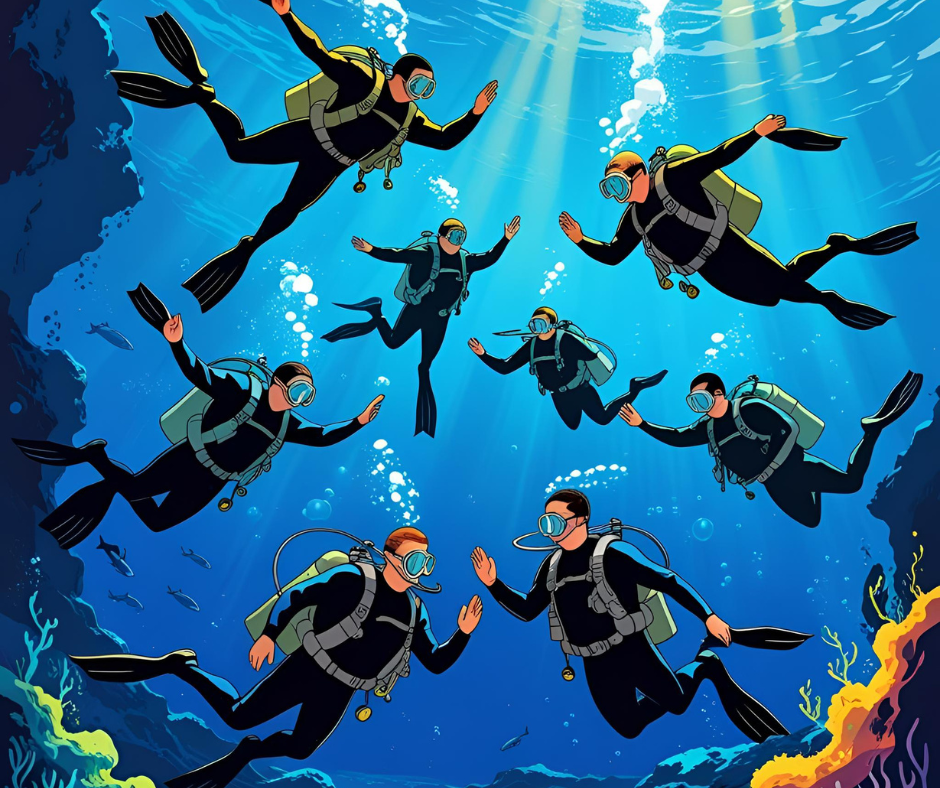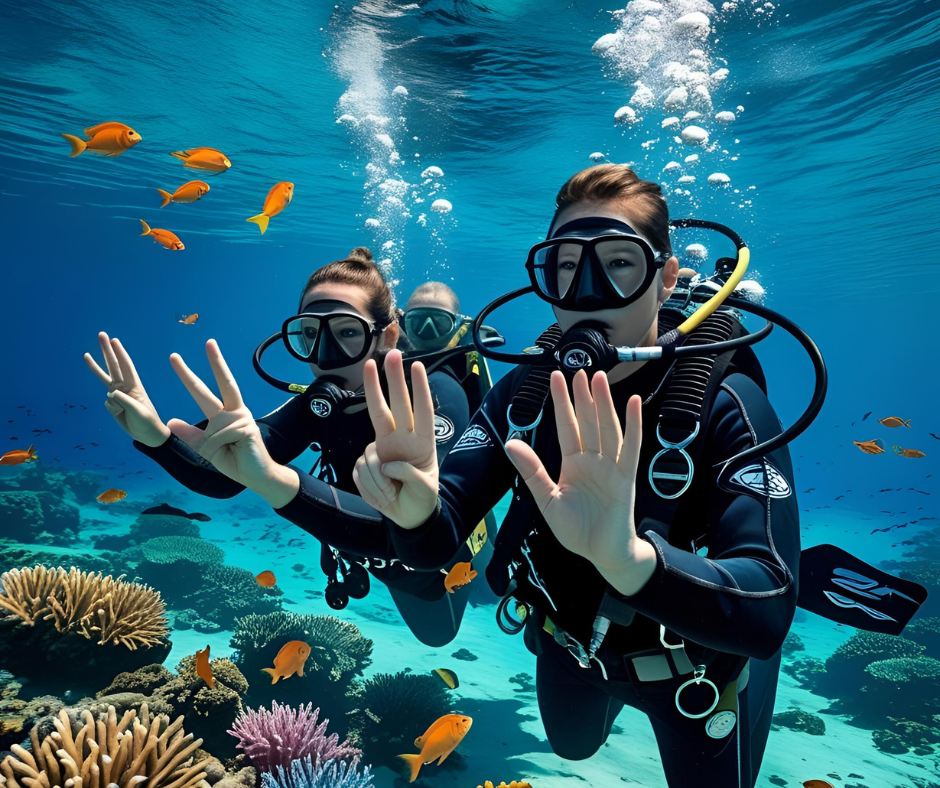Diving techniques play a critical role in ensuring a safe and enjoyable scuba diving experience, especially when it comes to underwater communication. Unlike on land where words flow freely, the underwater world poses unique challenges due to the physical barrier of water, dive gear, and the need for silence to preserve marine life tranquility. This is where understanding and mastering underwater dive signals comes into play. For any diver—whether a beginner or an experienced adventurer—knowing the appropriate diving techniques to communicate efficiently is essential for safety, navigation, coordination, and even emergency situations.
In this comprehensive guide, we’ll explore the importance of underwater communication, the various hand signals used in diving, and how specific diving techniques can enhance signal visibility and interpretation. By integrating proven diving practices, divers can ensure clear communication with their buddies and dive groups, minimizing risks and elevating their underwater adventures.
The Importance of Communication Underwater
Communication is one of the fundamental pillars of scuba diving safety. Since verbal communication is impossible underwater, divers rely on a standardized set of hand signals, light cues, and written communication boards to convey messages. Proper communication prevents misunderstandings, accidents, and confusion in situations that could otherwise escalate quickly.
Using effective diving techniques is vital to ensuring these signals are clear, especially in low-visibility or deep-water environments. For example, keeping hand signals within the buddy’s line of sight, ensuring proper body positioning, and maintaining buoyancy control are all diving techniques that contribute to successful communication.
Diving practices also ensure that divers maintain a close enough proximity to interpret each other’s signals, especially in currents or during night dives where visibility is reduced. When divers are trained in proper diving techniques for positioning and signaling, they can quickly interpret essential messages like “Out of Air,” “Stop,” or “Ascend,” ensuring prompt and appropriate responses.
Standardized Hand Signals Every Diver Must Know
Hand signals form the core of underwater communication. Just as language varies on land, standardized signals provide a universal ‘language’ underwater. Here are the most common hand signals every diver should master, practiced through reliable diving practices:
- OK Signal:
Touching your thumb and index finger together to form a circle while keeping the other fingers extended. This is the universal sign for “I’m okay.” Using diving practices such as controlled buoyancy ensures that this signal remains visible and steady. - Not OK / Problem Signal:
A flat hand rocked side to side, signaling discomfort or an issue. Applying diving techniques that stabilize the body allows the diver to effectively communicate this without further distress. - Up / Ascend:
A thumbs-up gesture signals the need to ascend. Diving techniques such as controlled fin kicks can help position oneself to maintain eye contact while signaling. - Down / Descend:
A thumbs-down gesture signals descent. Mastery of diving techniques like proper equalization and descent control is important when giving or responding to this signal. - Stop:
A flat hand held up, palm facing forward. Diving techniques that ensure a stationary hover improve the visibility of this critical signal. - Out of Air:
Drawing a flat hand across the throat communicates an out-of-air emergency. Rapid recognition of this signal, combined with emergency diving practices such as alternate air source sharing, can be life-saving. - Buddy / Stay Close:
Pointing two fingers together, representing “stick with me” or “buddy up.” Practicing diving techniques that maintain consistent spacing ensures you’re always close enough to see these signals. - Direction Signals:
Pointing fingers to indicate which way to swim. Proper orientation and diving practices for directional control allow divers to guide their buddy effectively.
These standardized hand signals, when paired with the appropriate diving techniques, form a crucial communication toolkit for every dive.
Diving Techniques to Enhance Communication
To ensure that underwater communication is seamless, divers must employ specific diving practices. Here are several ways diving techniques can enhance signal clarity and comprehension:
- Buoyancy Control
One of the foundational diving techniques, buoyancy control allows a diver to maintain a stable position in the water column. Poor buoyancy can lead to erratic movements, making hand signals difficult to interpret. By mastering this skill, divers can hover steadily, ensuring clear signaling. - Proper Finning Techniques
Using proper finning methods, such as the frog kick or flutter kick, helps reduce silting and maintains a clearer line of sight. Divers practicing these diving techniques avoid kicking up sand or debris that could obscure signals. - Body Positioning and Orientation
Facing your dive buddy directly and ensuring you are within each other’s visual range are vital diving practices. This way, signals are not just sent but also seen and understood. - Use of Dive Lights
During night dives or in low-visibility conditions, dive lights are indispensable. Effective diving techniques include how to angle and use lights to illuminate hand signals without blinding your buddy. - Slow and Deliberate Movements
Rapid or jerky hand gestures can be confusing. Diving practices that emphasize slow, deliberate movements ensure signals are distinct and easy to interpret. - Consistent Eye Contact
Before signaling, catching your buddy’s attention with direct eye contact ensures they are focused and ready to receive the message. Diving techniques that help maintain consistent eye contact include controlled breathing and positioning.
By integrating these diving techniques into their routines, divers can significantly improve the efficiency of their underwater communication.
Beyond Hand Signals: Other Communication Tools
While hand signals are primary, other methods and tools aid underwater communication:
- Slates and Wetnotes: Writing boards that allow divers to jot down messages. Using slates requires diving techniques such as neutral buoyancy to stay steady while writing.
- Underwater Noisemakers: Devices like tank bangers or shakers grab attention with sound. Implementing diving techniques to pause movements and listen carefully ensures you catch these auditory cues.
- Line Pull Signals: In technical or cave diving, where visibility is often zero, line pull signals become essential. Mastery of these specialized diving techniques ensures that each tug or pull is clear in meaning.
These alternative methods, combined with diving techniques that aid stability and focus, form a comprehensive communication system for divers.
Practicing Dive Signals with Proper Diving Techniques
Regular practice of dive signals, coupled with effective diving practices, is necessary for building confidence and muscle memory. Here are tips for practicing:
- Pre-Dive Briefings
Before each dive, buddies should review and agree on the dive plan and signals. This ensures clarity and refreshes signal knowledge. - Pool Practice
Using controlled environments like swimming pools to rehearse hand signals allows divers to focus on both diving techniques and communication without environmental stress. - Role-Playing Scenarios
Simulating emergencies or directional changes during practice dives helps divers apply both signals and diving techniques under simulated stress conditions. - Advanced Courses
Taking advanced diving courses often includes modules on diving techniques for effective communication, especially in complex dive conditions.
Through consistent practice, divers internalize both the signals and the diving techniques that enhance them, leading to safer and more coordinated dives.
Common Communication Mistakes and How to Avoid Them
Despite best efforts, miscommunication can still occur underwater. Here are common mistakes and how diving practices can help avoid them:
- Poor Visibility of Signals:
Avoid by using buoyancy control to stabilize and signal at chest height where it’s visible. - Misinterpretation of Signals:
Standardize hand signals with your buddy before the dive. Reinforce understanding through regular practice. - Lack of Attention:
Maintain situational awareness and keep your buddy in sight. Diving techniques like proper spacing help ensure no one drifts too far. - Overcomplicated Gestures:
Stick to simple, universally recognized signals. Using slow, clear hand movements as part of your diving techniques ensures clarity.
By being mindful of these pitfalls and focusing on refining diving techniques, communication becomes more reliable.
Conclusion
Mastering underwater communication is a cornerstone of safe and enjoyable diving. From standardized hand signals to alternative tools like slates and noisemakers, effective communication is made possible through the application of refined diving techniques. Whether it’s controlling buoyancy, maintaining eye contact, or positioning correctly, diving techniques form the backbone of clear, unmistakable signals beneath the waves.
As you continue your diving journey, remember that every hand signal you practice and every diving technique you master brings you closer to becoming a more competent, confident, and considerate dive buddy. Prioritize these skills, and you’ll not only communicate better but also deepen your appreciation for the incredible underwater world.
Summary of Key Diving Practices for Underwater Communication:
- Buoyancy control for signal stability
- Proper finning to avoid visibility obstruction
- Direct body orientation towards dive buddies
- Strategic use of dive lights in low visibility
- Slow, deliberate hand movements
- Consistent eye contact before signaling
- Regular practice and pre-dive briefings
With these diving techniques ingrained, your underwater communication will be as fluent and effective as if you were speaking on land—only much cooler, because it’s under the sea!


